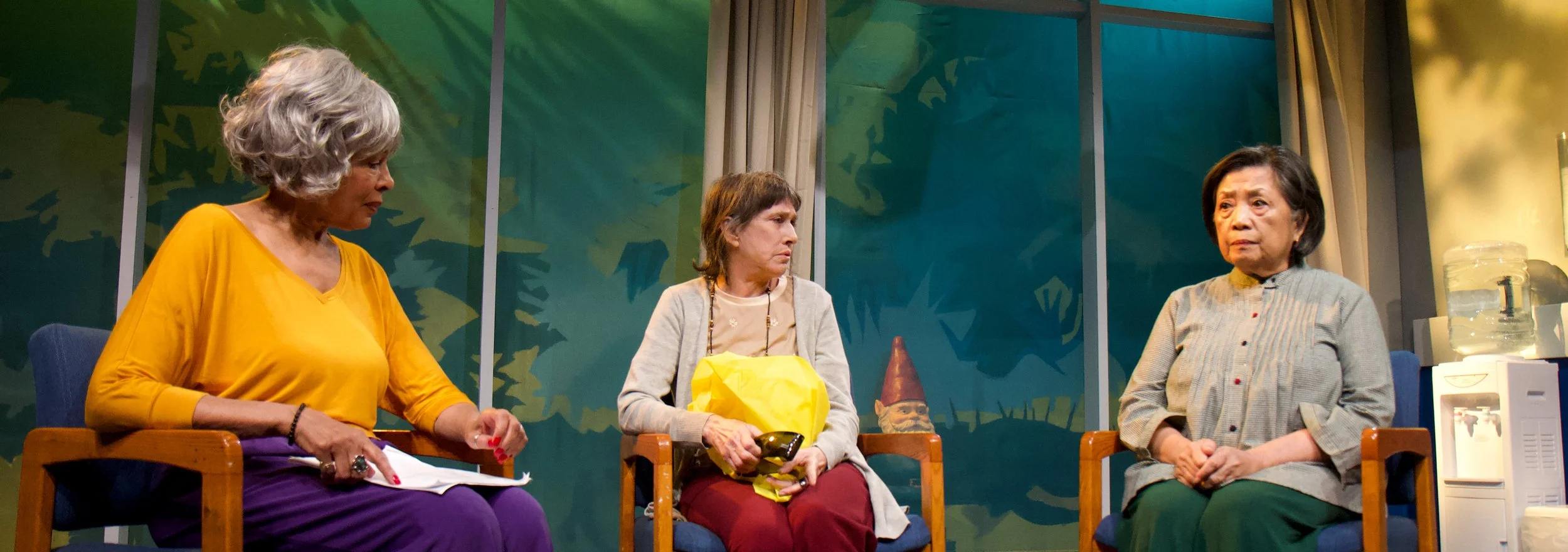In this theatrical age of digital scenery, hybrid storytelling and contemporary subject matter, Reunions seems old-fashioned with its painted backdrop for scenery and simply told stories set in pre–World War I Europe. Yet from this old-fashioned presentation come many of the show’s pleasures, including some charming ditties, fine period costumes and note-perfect performances, particularly by a couple of beloved old hands of the New York stage.
We Had a World
Every unhappy family is unhappy in its own way, Leo Tolstoy famously wrote in his opening line of Anna Karenina, and Joshua Harmon shows that every unhappy family member is unhappy in her own way in We Had a World, his stirring new play that gets at universal truths through a very personal story.
Poor Yella Rednecks
By this point, the plays of Qui Nguyen are starting to look like “seen one, seen them all.” From his earliest productions, for downtown theater troupe Vampire Cowboys, Nguyen’s works have their hallmarks: comic-book-style scenic design, martial arts, superhero and pop-culture fandom. The playwright has often been acclaimed for inventive storytelling and stagecraft. But now that he’s deployed the same gimmicks in play after play, their novelty has worn off. In Poor Yella Rednecks, Nguyen’s latest show to debut in New York, they seem obtrusive. The play is solidly plotted, with thoughtful, moving dialogue scenes. It could shed all the whiz-bang surrealities and still be a worthwhile, entertaining dramedy.
The Best We Could
An hour into The Best We Could, you realize you’re not watching the play you thought you were. Emily Feldman’s new drama seemed like it was a semi-experimental staging of a cross-country drive during which a grown woman and her dad visit national parks and revisit moments in their lives. Then, all of a sudden, it’s about something very specific beyond the sightseeing, bonding and memories. And the play belongs to a particular category of stories—and that category is not road trips or family relationships or Our Town riffs.
The Daughter-in-Law
D. H. Lawrence wrote The Daughter-in-Law in 1912–13, at the age of 27, around the same time as his novel Sons and Lovers. The play’s first production came posthumously, in 1967. There have been very few productions since, one of which was by the Mint Theater Company, in 2003, fulfilling its mission to “find and produce worthwhile plays from the past that have been lost or forgotten.” Now Martin Platt, who directed that production, again takes the reins for the company’s revival of The Daughter-in-Law, currently playing at City Center Stage II.
Harry Townsend’s Last Stand
Toward the end of Harry Townsend’s Last Stand, a play that’s set in a New England lake house and revolves around the strained relationship between an aging father and his adult child, a door is opened and the call of a loon is heard. It immediately brings to mind On Golden Pond (“The loons, Norman!”), a play that’s set in a New England lake house and revolves around the strained relationship between an aging father and his adult child. This association doesn’t do Harry Townsend any favors, though, since its parent-child relationship is not as well developed as the one in On Golden Pond and, consequently, the conflict and emotions feel forced.
Bat Out of Hell: The Musical
Jim Steinman’s Bat Out of Hell: The Musical is a high-octane show that has a way of staying with you long after the curtain closes. The songs are taken from Meatloaf’s 1977 debut album, Bat Out of Hell, which provided a narrative about love and teenage angst for a generation of rock-and-roll fans. Director Jay Scheib, best-known for contemporary stagings of classical and contemporary works, has combined straightforward musical theater elements with avant-garde practices (such as a handheld camera that isolates and projects the faces of the characters in situ). The overall affect is of a raucous rock musical that captures the spirit of a concept album.
In the Body of the World
The Manhattan Theatre Club stage at City Center is giving off major Disney World Jungle Cruise vibes these days. Birds call over the syncopated groove of Nigerian percussionist Solomon Ilori’s 1963 deep cut “Tolani (African Love Song)” as patrons enter the theater. There’s a Tara Buddha statue downstage right, some Persian rugs, a scarlet chaise lounge and some cushions on the floor, and the proto-Afrobeat music morphs into the Middle Eastern goblet drums and chirpy marimba that have been cornerstones of “world music” for decades. It’s almost disappointing when no chipper, punning Adventureland employee pulls up to take you downriver.
Ring Twice for Miranda
Alan Hruska’s Ring Twice for Miranda, at City Center Stage II, is not the only recent play that features a dystopian society—it joins last year’s Mercury Fur (by Philip Ridley), and Caryl Churchill’s Escaped Alone, recently at BAM, and Wallace Shawn’s Evening at the Talk House, playing at the Signature Theatre Center. Unlike those, however, it has startling echoes of—or perhaps pays homage to—European plays from the middle part of the last century—particularly ones by Jean Genet, Samuel Beckett and Jean Giraudoux.















